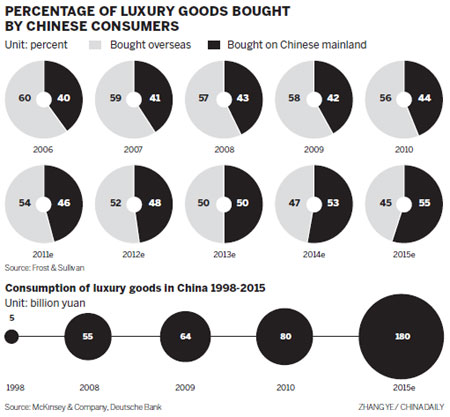Chinese snap up luxury products
Updated: 2012-02-07 07:56
By Wang Zhuoqiong (China Daily)
|
||||||||
"Increasing living standards, a growing urban population and anti-piracy laws and regulations" also contributed to the increasing demand for luxuries, the report said, predicting second- and third-tier cities will become markets for the expansion of top brands.
Zhu said that although the growth of the high-end market in lower-tier cities outpaced that in first-tier cities, markets in Beijing and Shanghai could still maintain double-digit growth.
Another report released by the Research Center for Luxury Goods and Services at the University of International Business and Economics (UIBE) in Beijing also saw potential growth for markets in lower-tier cities.
Cities such as Hangzhou, Shenyang, Chengdu and Qingdao would become the main markets for competition in the luxury brand sector, said the UIBE report, predicting sales in Hangzhou will reach 8 percent of the domestic sales volume, followed by 6 percent in Shenyang, 5 percent in Chengdu and 3 percent in Qingdao.
"Markets in first-tier cities such as Beijing and Shanghai are highly mature," said the UIBE report, adding that in lower-tier cities, the limited marketing and promotional activities and sales channels would challenge the expansion of designer brands.
"But e-commerce services for the brands would make up the gap," it added.
On the Chinese mainland, the online transaction volume of luxury goods was 6.36 billion yuan in 2010, said a report published by iResearch Consulting Group. It expected it to reach 10.73 billion yuan in 2011 and 21.32 billion yuan by 2013.
Because of limited sales channels, limited brands and choices available, Chinese people prefer purchasing luxury goods in overseas markets, causing a huge imbalance in buying volumes between domestic and overseas markets, said the Frost & Sullivan report.
It said wealthy Chinese bought 123 billion yuan of luxury goods in overseas markets in 2010 compared with 95 billion yuan in the domestic market.
However, it expects the purchasing of luxury goods on the Chinese mainland - 46 percent of global consumption last year - to surpass that in overseas markets by 2014.
According to industry insiders, the imbalance is mainly driven by the huge price gap of luxury items between domestic and overseas markets, with much higher taxes imposed on high-end goods creating higher prices on the Chinese mainland.
According to Ouyang Kun, chief of the World Luxury Association's China office, many other countries do not impose tax on luxury goods, so the prices were lower there.
Chen Keyu contributed to this story.
China Daily


 Relief reaches isolated village
Relief reaches isolated village
 Rainfall poses new threats to quake-hit region
Rainfall poses new threats to quake-hit region
 Funerals begin for Boston bombing victims
Funerals begin for Boston bombing victims
 Quake takeaway from China's Air Force
Quake takeaway from China's Air Force
 Obama celebrates young inventors at science fair
Obama celebrates young inventors at science fair
 Earth Day marked around the world
Earth Day marked around the world
 Volunteer team helping students find sense of normalcy
Volunteer team helping students find sense of normalcy
 Ethnic groups quick to join rescue efforts
Ethnic groups quick to join rescue efforts
Most Viewed
Editor's Picks

|

|

|

|

|

|
Today's Top News
Health new priority for quake zone
Xi meets US top military officer
Japan's boats driven out of Diaoyu
China mulls online shopping legislation
Bird flu death toll rises to 22
Putin appoints new ambassador to China
Japanese ships blocked from Diaoyu Islands
Inspired by Guan, more Chinese pick up golf
US Weekly

|

|






